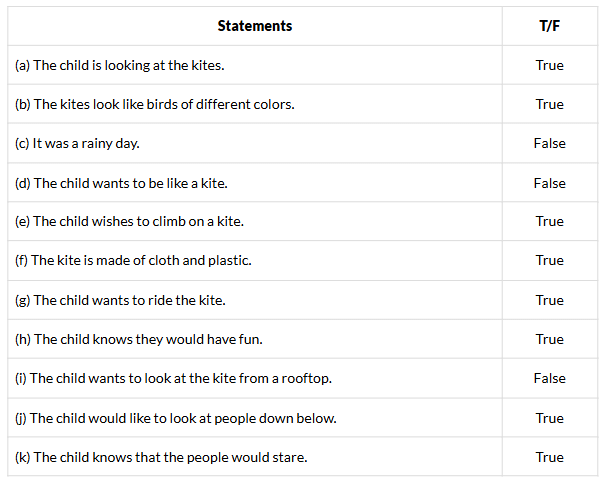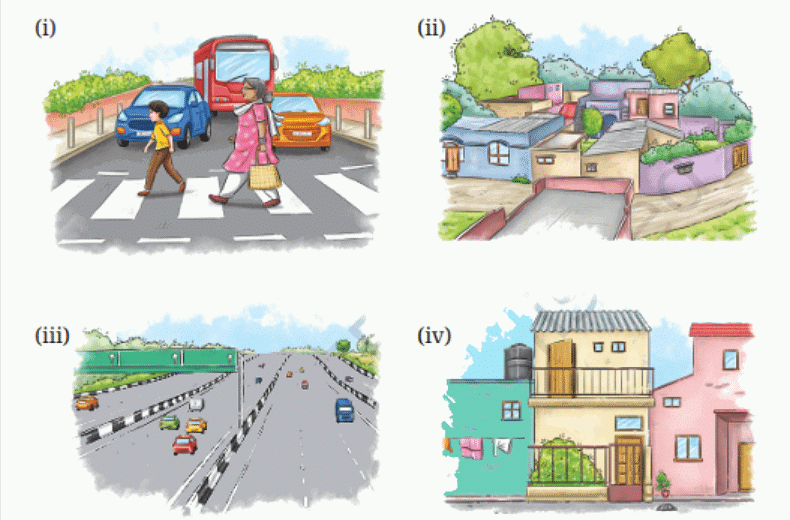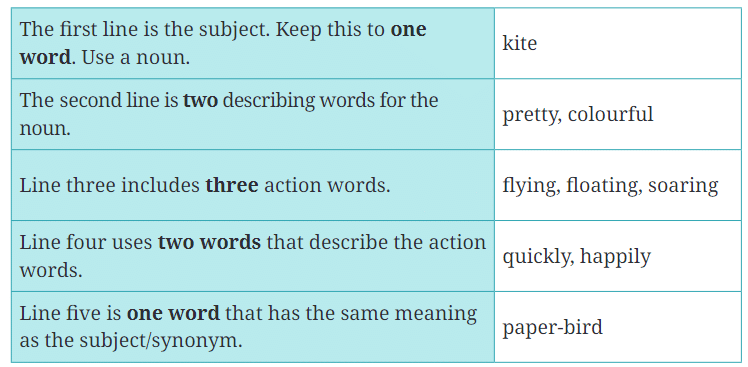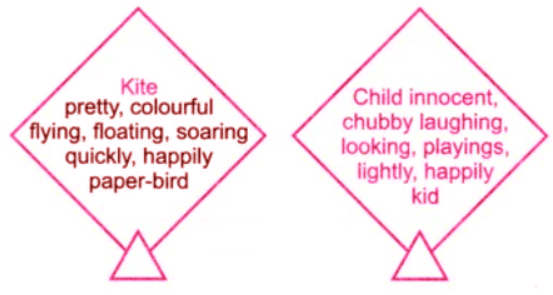The Kites NCERT Solutions | English for Class 6 PDF Download
| Table of contents |

|
| Let us do these activities before we read |

|
| Let us discuss |

|
| Let us think and reflect |

|
| Let us learn |

|
| Let us listen |

|
| Let us speak |

|
| Let us write |

|
| Let us explore |

|
Let us do these activities before we read
Page 141
Q1: Answer the following questions and share them with your teacher and classmates.
(a) Have you ever flown a kite or seen someone fly it? Where? When?
Ans: Yes, I have flown a kite during the kite festival in January at the local park.
(b) Describe the kite—colour(s), shape, design of tail, any other detail.
Ans: The kite was diamond-shaped, with bright red and blue colors, and had a long tail with small ribbons attached.
(c) What did you think when you saw the kite up in the sky?
Ans: I thought the kite looked beautiful and free, soaring high in the sky, and I felt a sense of joy watching it.
Q2: Search the internet for videos on Kite Festivals and watch them with your teacher and classmates.
(a) Share the things with your teacher that you saw and what the people were doing.
Ans: In the videos, I saw people flying kites of various shapes and sizes, participating in kite flying competitions, and enjoying the festive atmosphere.
(b) Would you like to participate in this kind of festival? Why?
Ans: Yes, I would like to participate because it looks fun and exciting to fly kites with others and be part of the celebration.
(c) What kind of kite would you like to fly?
Ans: I would like to fly a large, colorful kite shaped like a dragon.
Q3: Look at the picture and complete the sentences. Share your responses with your teacher.

(a) I can see ___________, ___________ and ___________ in the picture.
Ans: I can see kites, birds, and the sky in the picture.
(b) The weather in the picture is ___________.
Ans: The weather in the picture is windly.
(c) The kite is ___________ high in the sky.
Ans: The kite is flying high in the sky.
(d) The child is ___________ from below.
Ans: The child is looking from below.
(e) The tail of the kite ___________.
Ans: The tail of the kite has ribbons.
Q4: Now, think and answer.
(a) List two more things that you want to add to the picture.
Ans: Sun, Aeroplane
(b) If I were the child, I would ___________
Ans: love to play with the birds.
(c) If I were the kite, I would ___________
Ans: love to fly high.
Let us discuss
Page 143, 144
Q1: Read the poem silently. As you read, mark the given statements as True or False. Ans:
Ans:
Q2: Complete the following sentences.
(a) The poet says that the kites are like coloured birds – See the kites fly/Like coloured birds in the sky.
Ans: The kites have been compared to birds because they fly high and look colourful.
(b) The child wishes to be like air – I wish I were small / And as light as air.
Ans: The child wishes to be as light as air. The child wishes this to be able to climb on a kite and fly.
Do you think that the use of simile in this poem helps us imagine better when we read the poem? Share your thoughts with your teacher and classmates.
Ans: Yes, the use of simile in the poem helps us imagine the kites as colourful birds and the child being as light as air, enhancing our visualization of the scenes described in the poem.
Q3: Find a set of words from the poem that begin with the same consonant sound.
Stanza 1: Which consonant sound do both words begin with?
Stanza 3: Which consonant sound do both words begin with?
This is called alliteration. For example, big bright blue bag, funny fan, etc.
Create 4 other sets of words using alliteration.
Ans: Stanza 1: wild – wind
Stanza 3: stand – stare
Others: fly – flare
Alliteration Examples:
- Bouncing balloon, bright bird
- Dusty dawn, dreamy days
- Sweet smiles, silver star
- Calm cat, crisp crackers
These examples showcase alliteration by using the same consonant sound at the beginning of each word in the set.
Q4: In the last stanza, the two words that the poet repeats are __________, __________ to tell us that the kite is flying __ __ __ y high.
Ans: In the last stanza, the two words that the poet repeats are high, high to tell us that the kite is flying very high.
Q5: Study each stanza and underline the rhyming words from the end of each line. Also, circle the end words in the stanzas that do not rhyme.
Ans:
- Stanza 1: fly - sky
- Stanza 2: air - there
- Stanza 3: wings - sings
- Stanza 4: down - town
- Stanza 5: stare - air
Rhyming Words in Each Stanza:
- fly and sky
- air and there
- wings and sings
- down and town
- stare and air
Let us think and reflect
Page 144
Q1: Read the given lines from the poem and answer the following questions.
What fun it would be
To look right down,
Over the park
And the rooftops of town.
(a) Circle the word that does not share the same feeling as ‘fun’:
joy, excitement, care, happiness
Ans: Care
(b) Which line tells us that the poet was somewhere above?
Ans: "To look right down"
(c) Choose the scene the child saw.
 Ans: Based on the poem, the child is imagining looking down from high up in the air, seeing the park and the rooftops of the town.
Ans: Based on the poem, the child is imagining looking down from high up in the air, seeing the park and the rooftops of the town.
The appropriate scene that matches this description is Scene (ii): This scene shows an aerial view of houses and trees, which aligns with the child’s perspective of looking down over the park and rooftops of the town from a high vantage point.
Q2: Answer the following questions.
(a) How does the poet describe the kites in the first two lines?
Ans: In the first two lines of the poem “Kite,” the poet often describes the kites with vivid imagery, capturing their beauty and movement in the sky.
(b) Why does the child say that they have to climb a tree first to get onto the kite?
Ans: The child says they have to climb a tree first because they imagine themselves being small and light enough to climb onto the kite and fly.
(c) What are the songs that the child hears when flying atop the kite?
Ans: The songs that the child hears are the sounds made by the wild wind.
(d) Why did the people look up at the child and stare? If you looked up and saw that, what feelings would you have?
Ans: The people looked up and stared because it was unusual and amazing to see a child flying on a kite. If I looked up and saw that, I would feel astonished and excited.
(e) If you were the kite carrying the child high up in the air, what would you tell them?
Ans: If I were the kite, I would tell the child to hold on tight and enjoy the beautiful view from above, feeling the wind and freedom of flying.
Let us learn
Page 146, 147, 148
Q1: Look at the picture of the kite and read what some of its parts are named.
 Now, Complete the given conversation by filling the blanks with some ‘parts of a kite’ words from above.
Now, Complete the given conversation by filling the blanks with some ‘parts of a kite’ words from above.
Bina: I love the long yellow t _ _ _ at the end of my kite. What colour is your kite?
Saroj: My kite’s c _ _ _ _ is pink. The s _ _ _ _ e is black.
Bina: Oh wonderful! My kite l _ _ _ is red. The r_ _ l that wraps it is green. I like it.
Saroj: My kite line is red too. The tip of my kite has a blue _ _ _ e.
Bina: Beautiful! Let’s go and fly our pretty kite.
Ans: Bina: I love the long yellow tail at the end of my kite. What colour is your kite?
Saroj: My kite’s cover is pink. The spine is black.
Bina: Oh wonderful! My kite line is red. The reel that wraps it is green. I really like it.
Saroj: My kite line is red too. The tip of my kite has a blue nose.
Bina: Beautiful! Let’s go and fly our pretty kite.
Q2: Let us create a poem using words in a kite!

This is called a cinquain poem. It is a five-line poem that describes a person, a place, or a thing.
Now, create a cinquain poem yourself on anything you like.
Ans: 
Q3: The poet uses the words ‘fly’ and ‘drift’ to describe the kite’s movement.
(a) Circle the words matching the ‘drift’ movement. You can choose more than one word. Ans:
Ans: 
(b) Study some other words about the kite’s movement and share what type of movement they show. You can look at (a) for the type of movement. Ans: Other words about the kite’s movement and the type of movement they show:
Ans: Other words about the kite’s movement and the type of movement they show:
- Glide: A smooth and continuous movement, often slow and graceful, similar to drifting.
- Dive: A fast and downward movement, often sudden.
- Soar: A fast, upward movement, often high and with sustained motion.
- Swoop: A fast movement, typically downward and then upward again, often sudden.
- Circle: A movement going round and round, maintaining a steady path.
Q4: The poet has used expressions like-
up in the air; look right down; stay up there; stand and stare
(a) Read how these expressions are used in the poem.
Ans: Usage of Expressions in the Poem:
- Up in the air: “Up in the air/See the kites fly,”
- Look right down: “What fun it would be/To look right down,/Over the park/And the rooftops of town.”
- Stay up there: “I would climb on a kite/And sail up there.”
- Stand and stare: “The people below/Would stand and stare,/And wish they were me/High, high in the air.”
(b) In pairs, make sentences using these expressions. Discuss with your teacher and then write in your notebooks.
Ans: Making Sentences:
- Up in the air: We watched the hot air balloon rise in the air as the sun set behind the mountains.
- Look right down: From the top of the Ferris wheel, I could look right down and see the entire amusement park.
- Stay up there: The bird built its nest in the tree and decided to stay up there throughout the spring.
- Stand and stare: The street performer was so talented that people would stand and stare in amazement.
Let us listen
Page 148
Listen about the Kite Festival in India. As you listen, circle the words that are not correct. Then, listen again and write the correct words (refer to page 163 for transcript) .
(a) Kite Festival is celebrated during the month of June.
Ans: False (January)
(b) The International Kite Festival is named Uttarayan in Eastern India.
Ans: False (Western India)
(c) Uttarayan is mainly celebrated in Gujarat, but also in Maharashtra and Telangana.
Ans: True
(d) During the Kite Festival, we can see kites of different shapes, sizes and colours.
Ans: True
(e) In Karnataka, the Tourism Department organises the kite festival every year.
Ans: True
(f) The Punjab region celebrates Basant Panchami and Baisakhi by flying kites.
Ans: True
(g) People of India also enjoy flying kites on Earth Day.
Ans: False (Independence Day)
Let us speak
Page 149
Q: Share a kite-flying experience with your classmates. If you have not flown a kite yet, share an experience of watching kites fly. Give details—Where? When? Why? How? Speak in complete sentences.
Ans: I have flown a kite during the Makar Sankranti festival in January. It was at the local park where many people gathered to fly kites. The weather was perfect with a gentle breeze, making it ideal for kite flying. I flew a colorful diamond-shaped kite with a long tail. It was an exhilarating experience to see my kite soaring high in the sky, competing with other kites. The excitement and joy of controlling the kite and keeping it from being cut by other kites made the day memorable.
Let us write
Page 149
Q1: Imagine yourself as a kite. In pairs, first discuss all the following hints.
What shape of kite are you? What colours do you have? What other parts of yourself are you happy about?
Ans:
- I am a diamond-shaped kite, the classic and elegant form that gracefully glides through the air.
- My body is a vibrant mix of blues and greens, with a golden tail that sparkles in the sunlight.
- I am proud of my long, fluttering tail that adds to my stability and beauty in flight.
Where are you? Who do you belong to? What activities do you do? Who are your friends?
Ans:
- I am often found soaring in the open skies above a lush, green park.
- I belong to a young child named who loves to fly me on weekends and during festivals.
- I enjoy dancing with the wind and competing with other kites.
Do you have any message for humans?
Ans: Message for Humans: Friends, I want to remind you to find joy in simple pleasures and to look up at the sky more often. Let the wind carry your worries away and embrace the freedom and beauty that nature offers.
Q2: Now, write a paragraph of about 100 words, with the title – I am a Kite.
Ans: I am a Kite
I am a kite, flying high in the blue sky. The wind carries me up and down, making me dance with joy. My bright colors shine under the sun, and children love to watch me soar. Sometimes, the wind is strong, and I glide smoothly. Other times, it is weak, and I struggle to stay up. My string connects me to the hands of my owner, who controls my movement. I love the feeling of freedom in the air. But I know that one day, my string might break, and I will drift away into the unknown.
Let us explore
Page 149
Q1: The mention of kites exists in ancient Indian texts. It can be found in the poetry of the thirteenth-century Marathi saint and poet, Namadeva. In his poems or gathas, he called a kite a gudi, and there is a mention that the kites were made from kaagad (paper).
Ans: The Ancient Tradition of Kites in India:
The tradition of kite flying in India is ancient, with mentions in historical texts and poetry. In the thirteenth century, the Marathi saint and poet Namadeva referred to kites as qudi in his qathas (poems). Fie described kites as being made from kaagad, meaning paper. This indicates that kite flying was a popular and cherished activity even in ancient times. Namadeva’s poetic references highlight the cultural significance and the joy associated with kite flying in Indian society. This tradition has been passed down through generations, continuing to bring delight and excitement to people of all ages across India.
Q2: Have a look at some of the different types of kites. Choose which one is commonly seen.
(a) Find out the steps to make a kite.
Ans: Step to make a kite:
- Prepare the Frame using wooden dowels or bamboo sticks.
- Attach the Frame to the Kite Material and secure it with glue or tape, ensuring the material is taut and well-attached to the frame.
- Make a small hole at the top and bottom of the vertical stick and the ends of the horizontal stick.
- Add the String.
- Cut a piece of cloth or ribbon to use as the tail.
- Use markers or paint To decorate your kite with patterns, colors, or a message.
(b) Follow the steps and create your kite. Get it to school to show your teacher and classmates.
Ans: Create the Frame:
- Measure and cut the dowels. The longer dowel (spine) should be about 24 inches, and the shorter dowel (crossbar) about 20 inches.
- Lay the shorter dowel across the longer one to form a cross, about one-third of the way down the longer dowel.
- Secure the two dowels together using string or strong tape at the intersection. Make sure they form a right angle.
Make the Cover:
- Place the frame on the paper or fabric and trace the outline of the kite, leaving an extra inch around the edges for folding.
- Cut out the kite shape from the paper or fabric.
- Fold the edges of the paper or fabric over the frame and secure with glue or tape.
Attach the String:
- Cut a piece of string about twice the length of the spine.
- Tie one end of the string to the top of the spine and the other end to the bottom.
- Attach another piece of string at the intersection of the dowels for the kite line.
Add the Tail:
- Attach the ribbon or fabric to the bottom of the kite. This helps to stabilize the kite in the wind.
Decorate:
- Use markers or paint to decorate your kite. You can write a message like “Happy Independence Day!” on it.
Creating and Flying Your Kite:
- Follow the steps above to create your kite.
- Once your kite is ready, take it to an open area with plenty of wind.
- Fly your kite and enjoy!
(c) Write a message on the kite. For example: Happy Independence Day!
Ans: Example message: “CHASE YOUR DREAMS!”
|
66 videos|528 docs|71 tests
|
FAQs on The Kites NCERT Solutions - English for Class 6
| 1. What themes are explored in the poem "The Kites" from Class 6 NCERT? |  |
| 2. How does the poet describe the experience of flying kites? |  |
| 3. What literary devices are used in "The Kites"? |  |
| 4. Why is kite flying considered a popular activity in many cultures? |  |
| 5. What can students learn from the poem "The Kites" in terms of creativity and imagination? |  |
















